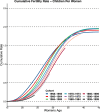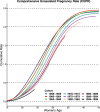Changes in the comprehensive unassisted pregnancy rate as a possible marker of declining human fecundity
- PMID: 40615501
- PMCID: PMC12227590
- DOI: 10.1038/s41598-025-08332-4
Changes in the comprehensive unassisted pregnancy rate as a possible marker of declining human fecundity
Abstract
Recent decades have seen declining total fertility rates (TFR) globally, alongside increased use of assisted reproductive technology (ART). However, TFR includes ART births and excludes induced abortions, complicating assessments of population fecundity. Here, we examine trends in cohort total fertility rates (cTFR), induced abortions, and ART use through a nationwide cohort study of 1,648,971 pregnancies, including abortions, among Danish women aged 15-45 years born between 1958 and 1999. A new index, the Comprehensive Unassisted Pregnancy Rate (live births and induced abortions, excluding ART births), was developed. Our findings reveal a decline in unassisted pregnancy rates for women born after 1961, with an accelerated decline for those born after 1970. In contrast, cTFR increased for women born between 1958 and 1970 before decreasing, driven by trends in induced abortions and ART births. These differences highlight a disconnect between cTFR and fecundity measures. The declining unassisted pregnancy rates, reduced abortions, and increased ART demand raise concerns about population fecundity. Understanding these trends' biological and socioeconomic drivers requires large-scale, transdisciplinary studies of representative populations. Our results emphasize the need for alternative measures, like the Comprehensive Unassisted Pregnancy Rate, to assess reproductive health and fertility trends accurately.
Keywords: Assisted reproductive techniques; Contraceptives; Fecundity; Fertility; Induced abortions; Trends.
© 2025. The Author(s).
Conflict of interest statement
Declarations. Competing interests: The authors declare no competing interests.
Figures



Similar articles
-
Lifetime Induced Abortions and Live Births: A 40-Year Historical Cohort Study.J Obstet Gynaecol Can. 2024 Sep;46(9):102612. doi: 10.1016/j.jogc.2024.102612. Epub 2024 Jul 14. J Obstet Gynaecol Can. 2024. PMID: 39004402
-
Antioxidants for male subfertility.Cochrane Database Syst Rev. 2022 May 4;5(5):CD007411. doi: 10.1002/14651858.CD007411.pub5. Cochrane Database Syst Rev. 2022. PMID: 35506389 Free PMC article.
-
Application of seminal plasma to female genital tract prior to embryo transfer in assisted reproductive technology cycles (IVF, ICSI and frozen embryo transfer).Cochrane Database Syst Rev. 2018 Feb 28;2(2):CD011809. doi: 10.1002/14651858.CD011809.pub2. Cochrane Database Syst Rev. 2018. PMID: 29489026 Free PMC article.
-
Antioxidants for female subfertility.Cochrane Database Syst Rev. 2017 Jul 28;7(7):CD007807. doi: 10.1002/14651858.CD007807.pub3. Cochrane Database Syst Rev. 2017. Update in: Cochrane Database Syst Rev. 2020 Aug 27;8:CD007807. doi: 10.1002/14651858.CD007807.pub4. PMID: 28752910 Free PMC article. Updated.
-
Metabolomics for improving pregnancy outcomes in women undergoing assisted reproductive technologies.Cochrane Database Syst Rev. 2018 Mar 16;3(3):CD011872. doi: 10.1002/14651858.CD011872.pub3. Cochrane Database Syst Rev. 2018. PMID: 29547689 Free PMC article.
References
-
- Skakkebæk, N. E. et al. Environmental factors in declining human fertility. Nat. Rev. Endocrinol.18(3), 139–157 (2022). - PubMed
MeSH terms
LinkOut - more resources
Full Text Sources
Medical

